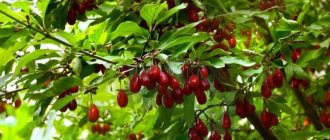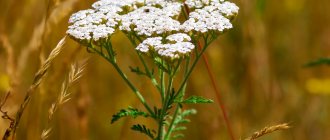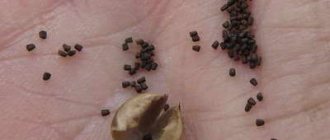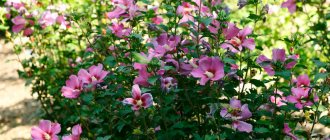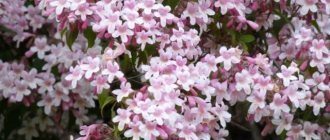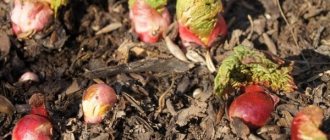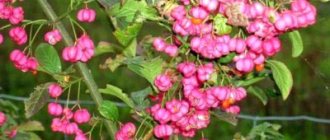Yarrow is a very large genus belonging to the Asteraceae or Compositae family. This genus includes about 150 species. Cut grass or common yarrow (Achillea millefolium) is considered the type species of the genus Yarrow. The name of such a plant comes from the name “Achilles”, this mythical hero healed wounds with the help of yarrow. Due to the many segments of the leaf blade, this plant received such a specific epithet (“mille” - thousand, “folium” - leaf). This plant is widespread throughout Asia and Europe, and it has also been brought to other continents. This culture prefers to grow in the steppe, forest and forest-steppe zones, among shrubs, in sparse forests, in wastelands, along the banks of reservoirs, in meadow steppes, on the edges, along roads, along ravines and on the outskirts of fields. Yarrow is cultivated as a medicinal, ornamental, and also a spicy plant.
Botanical description
Ornamental yarrow or Achillea is a perennial herbaceous plant of the Asteraceae family.
The height of the stem is 15-100 cm. The leaf blades are serrated and arranged alternately. The color of the stems and leaves is bright green - the plant looks decorative even outside the flowering season. During the flowering period, the bush is covered with small inflorescences collected in corymbs. Their diameter reaches 20 cm. The color is bright: sunny yellow, snow-white, lilac, purple, various shades of pink.
The natural habitat is vast: fields, meadows, steppes, mountain slopes of the temperate zone of the northern hemisphere.
Yarrow has been cultivated for hundreds of years. There are species that have medicinal properties. It is used for landscaping gardens, personal plots, and parks.
Planting and care
Although it is believed that ptarmika yarrow is decorative, in many ways it is similar to its “ordinary” relative - it is also unpretentious and can calmly grow and grow without constant care. Planting and caring for simple and ornamental plants are also largely similar. Let's look at them in more detail.
Reproduction
Yarrow propagation is carried out in four ways:
- Dividing the bush.
- Root sections.
- Green cuttings.
- Growing from seeds.
Dividing the bush
Dividing the bush is quite easy and the most rational way, taking into account the growth and development of yarrow. It is carried out mainly in the spring, but it can also be done in the fall. The “life” of yarrow in one place is 5 years. Then it needs to be transplanted. First, we dig up the entire bush along with the roots and separate it from the weeds. Then we divide it into several parts and place them separately in other places. When autumn comes, be sure to trim the stem, leaving shoots not exceeding 12 cm. You can carry out this method once every 2-3 years, without waiting for the five-year period. With this method of propagation, the mother bush is rejuvenated, which is beneficial for the plant itself.
Root segments
Propagation by root cuttings is the most “lazy” of all methods. This type of vegetative propagation occurs by separating a part of the root of the mother bush, 10-15 cm long, and then planting the section immediately in open ground to a depth of 10-12 cm according to the 25x50 and 40x40 pattern.
Green cuttings
It is advisable to carry out green cuttings in the summer, in early July, by cutting young shoots that have begun to become woody. The method is quite simple and effective. It is best to cut shoots in the morning. If a flowering specimen is taken, the flowers must be removed. The cut cutting, which contains two nodes, is immersed in the prepared liquid growth stimulator 1 cm deep and kept there for 10-12 hours, after which it is transferred to specially prepared moist soil. Planted to a depth of 1-1.5 cm and covered with a dark plastic bottle with perforations for better ventilation. After new leaves appear, the bottle is removed and carefully fertilized with a weak solution of mineral fertilizer.
Growing from seeds
Ornamental yarrow can also be grown from seeds. Sowing seeds in special boxes begins at the end of winter: later sowing dates can lead to a lack of flowering in the first year. Boxes for seedlings can be shallow. Preparation begins by mixing the fine-grained substrate with quartz sand (river) in a 1:1 ratio. Seeds are planted to a depth of no more than 2 cm. The distance between seeds should not be less than 3 cm. After sowing, the soil is moistened by spraying the surface layer through a spray bottle. Be careful not to soak the soil. The next step is to cover the box with plastic wrap and install the “mini-greenhouse” in a well-lit, warm place.
After 10-12 days, shoots will appear. After the first true leaf appears, you need to start picking and placing the seedlings in separate peat pots. Do this carefully, since the root system of small sprouts is very delicate and easily damaged. Moderate watering 1-2 times a week.
At the end of April, after the soil has warmed up, you can transplant the seedlings into open ground according to the scheme 25x25cm, 25x50 cm, 40x40 cm. We dig a shallow hole up to 10 cm in depth and move a peat cup there, then water it.
When transferring to the ground, be sure to highlight this place, since young shoots are very similar in appearance to weeds, and by mistake they can easily be weeded with others - “for company.”
The most common variety of yarrow ptarmika is “pearl oyster”, it is also called “white pearl” or “pearl”, a terry variety. Seeds are sold in specialized stores. The optimal planting interval is 40x40 cm. Suitable for cutting and winter bouquets. The plant is tall, can grow up to 75 cm. Flowering is abundant, “lush”, spherical. The flowers are white with a pearlescent tint. Flowering period up to 60 days. The beginning of flowering is the end of June, beginning of July. Loves well-lit places, but can also grow in partial shade.
Growing decorative yarrow from seeds
Yarrow seeds photo
Remember that seeds collected from hybrid plants do not retain the varietal characteristics of the mother plants. Therefore, you can only sow seed purchased in a specialized store, or seeds from your garden, collected from varietal plants.
Sowing in the ground
How to sow yarrow in the ground photo
- You can sow yarrow seeds in open ground before winter in late autumn.
- The bed is prepared in advance and well leveled so that there are no holes.
- Make small furrows at a distance of 15-20 cm, sow less frequently, preferably at a distance of 4-5 cm.
- The rows are covered with a rake and left until spring, mulching the bed with humus.
- In spring, seedlings are thinned out twice, leaving a final distance of 8-10 cm for low-growing varieties and 20-25 cm for tall ones.
Sowing seedlings
How to grow yarrow seedlings photo
Start sowing yarrow for seedlings at the end of February . Take fertile soil, mix with coarse sand, fill the box with the mixture.
- Sow the seeds in rows, keeping a distance of 3-4 cm.
- Deepen the seeds into the soil 0.5-1 cm.
- Spray the soil with a spray bottle.
- Cover the crops with film, ventilate them daily, and periodically moisten the soil.
- Sprout in a warm place with indirect light.
- Shoots will appear in 10-14 days.
- When 2 true leaves appear, plant them in separate containers (peat pots are ideal).
Scheme of picking yarrow seedlings
Picking is a procedure for transplanting plants into larger containers. It is optimal to plant yarrow seedlings when the first 2 true leaves appear. It is optimal to transplant seedlings into individual cups or pots with a volume of about 200 ml.
Before picking, be sure to water the plants a couple of hours before. It is very important to pick up the plants from a common bowl as carefully as possible, so as not to damage the roots; it is most convenient to do this with a wooden stick or a plastic spoon/fork. Then the plant is transplanted into a hole in a new container, covered with soil, carefully compacted and watered abundantly.
After picking, it is very important to protect the yarrow seedlings from direct sunlight for the first 3-5 days. Direct rays will cause stress in plants and slow down adaptation. To make plants stronger and take root faster in a new place, you can water the seedlings with a solution of a growth stimulator (for example, Zircon, Kornevin).
It is recommended to plant seedlings in dry, well-drained, preferably calcareous, soils. The distance between seedlings when planting is 25-30 cm. Replanting should be done using the transshipment method, that is, preserving the earthen clod.
How to care for yarrow in the garden
The combination of decorative yarrow with other flowers in the photo variety Achillea x Pretty Belinda
Yarrow grows best in open areas with bright light. Please note that yarrow can grow aggressively, drowning out neighboring crops.
Where to plant
It is unpretentious to the composition of the soil. Able to grow in depleted, sandy soils, but flowering will be more abundant when grown in nutritious, loose, alkaline soil.
Watering and fertilizing
- If the weather is dry, water once a week. The rest of the time it is content with precipitation.
- Does not require private feeding. Twice a season, feed with complex mineral fertilizer (in early spring before flowering and during flowering).
- It is not recommended to feed with organic matter.
Sanitary pruning and grass collection
Remove faded flowers regularly. This promotes the emergence of new ones and also protects against unwanted self-seeding.
The collection of inflorescences for further use for medicinal purposes is carried out right during flowering. Cut them, dry them, store them in a paper envelope.
In autumn, trim the shoots, leaving a length of 10-15 cm. The plant is cold-resistant, but if a cold winter is expected, mulch the soil with dry leaves.
Transfer
Every 5 years the plant should be replanted and the bush divided.
Diseases and pests
Decorative yarrow is resistant to diseases and pests. Occasionally it is affected by the striped weevil (larvae settle in the roots, adult insects eat the leaves). The soil should be treated with hexachlorane, and the above-ground part with chlorophos.
Amazing variety of species
Biologists count approximately 150 different varieties of yarrow. Many of them appeared thanks to the painstaking work of breeders. Let's look at the most popular of them.
Snow White Dew Drop
A cute perennial up to 60 cm high appeared relatively recently. Its main advantage is its luxurious white buds. They are collected in compact baskets, which are crowned with slender shoots. Thanks to the simple cultivation of yarrow from the seeds of Terry Dew Drop, many summer residents have started such a flower.
In order for the crop to appear in the flowerbed as early as possible, the seeds are sown in late February or early March.
To do this, use containers filled with fertile soil and perform simple operations:
- make shallow grooves;
- sowing seeds;
- cover them with earth;
- the top layer is slightly compacted;
- irrigate with a spray bottle.
Some gardeners grow yarrow in the garden in a simpler way. They sow seeds directly into open ground. Considering the climatic conditions, this can be done before winter or at the end of April.
For better plant germination, it is advisable to place the seeds in a cold place for stratification.
Attractive looking pearl mussel
The perennial is distinguished by its rhizome, which forms a huge number of shoots.
Thanks to this, it grows quickly, occupying more and more of the flowerbed area. Its erect stems reach 75 cm in height. The surface is strewn with small fibers, among which there are narrow leaves in the form of rays. Yarrow buds reach 2 cm in diameter. The petals are painted white. Some varieties of hybrids are distinguished by blue, purple or pinkish hues. In general, the inflorescences are spherical in shape and located at the top of erect shoots. Thanks to the simple cultivation of yarrow Pearl mussel from seeds, the crop is increasingly appearing in flower beds.
The process begins in early spring with the preparation of the substrate. It should contain equal amounts of river sand and fertile soil. Then it is placed in boxes, after which the seeds are sown to a depth of approximately 2 cm. Greenery will appear in 10 days. When it gets stronger, they pick it up, planting it in separate containers.
It is better to water with a liquid sprayer so that the seeds do not accumulate in one area.
Multi-colored paints of the Madison variety
The perennial has a powerful root system and straight stems that grow up to 70 cm. The dense inflorescences of Madison yarrow reach 15 cm in diameter.
The petals are painted in different colors. Flowering occurs in late July or early August. The culture miraculously tolerates dry times and is not afraid of the cold. It is successfully grown in group flower beds of a summer cottage. When dried, the flowers retain the original color of the petals, so they can be used to form winter bouquets.
The many faces of Ptarmika
The variety is characterized by a creeping rhizome, from which shoots grow up to 100 cm high. They are covered with small linear-lanceolate foliage.
During the flowering period, the shoots are crowned with white buds with a pearlescent tint. Yarrow is planted in different ways:
- seeds;
- by dividing the bush;
- cuttings;
- root segments.
Seeds are sown in seedling boxes in the traditional way. To carry out the procedure of dividing the bush, it is dug up along with the roots. Then carefully cut into several pieces. Cuttings are carried out in mid-summer using young shoots. The branches are placed in a solution of a growth stimulator for 12 hours, after which they are planted in the ground. As you can see, planting and caring for Ptarmika yarrow requires special effort from the gardener. However, later the work will bring a lot of joy when cute flowers appear in the garden.
The vibrant splendor of Red Velvet
The plant grows to approximately 80 cm in height. The erect stems are traditionally strewn with many elongated leaves. During flowering, the tops of the shoots are decorated with spherical baskets of bright color. The amazing Red Velvet Yarrow can give your garden a unique look. The main thing is to adhere to proper plant care.
Types of yarrow with photos and names
Yarrow lewisii variety King Edward Achillea x lewisii 'King Edward' photo
There are more than 150 plant species; let’s look at the most popular ones in gardening.
Achillea nobilis
Yarrow Achillea nobilis photo
The shoots reach a height of 0.5 m. The flowers are white with a yellow core. Blooms in early summer.
Silver yarrow Achillea clavennae
Silver yarrow Achillea clavennae photo
The height of the stem is 25 cm, the inflorescences are snow-white. The leaves are silvery-silky-hairy, pinnate, cut into several lobes, alternating, about 4-8 centimeters. This plant blooms profusely from June to August.
Achillea millefolium
Achillea millefolium photo
Inflorescences appear in mid-summer and last about 1.5 months. Color white, yellow, pink, purple.
Decorative pink yarrow Variety Achillea x millefolium 'Apple Blossom' photo
Multi-colored varieties look very beautiful in single plantings and are attractive in mixed combinations.
Yarrow ptarmica or pearl oyster Achillea ptarmica
Yarrow ptarmica or pearl oyster Achillea ptarmica photo
The compact bush reaches a height of 1 m. The leaves are small, oblong in shape. The reed inflorescences are arranged in several rows, forming a ball shape, and are painted white with a pearlescent tint. Blooms for a couple of months.
Achillea ptarmicoides
Achillea ptarmicoides photo
The leaf blades and stems are grayish in color. Flowering in June. The core of the flowers is cream-colored, the reed inflorescences are white.
Achillea filipendulina
Yarrow Achillea filipendulina variety Cloth of Gold photo
Reaches a height of 1.2 m. Flowers in July-August. Golden inflorescences.
Achillea tomentosa
Felted yarrow Achillea tomentosa variety Goldie photo in the garden
Reaches a height of no more than 15 cm, grows 45 cm wide. It blooms in August. Yellow inflorescences.
Keller's yarrow Achillea x kellereri
Keller's yarrow Achillea x kellereri photo
The height of the bush is 15 cm. The flowers are snow-white.
Achillea ageratifolia
Achillea ageratifolia photo in the garden
The height is 15-20 cm. The leaves are oblong and pubescent. Single baskets reach a diameter of 2.5 cm, the reed petals are snow-white.
Features of yarrow
The herbaceous perennial plant yarrow is rhizomatous and well-leafed. The height of the shoots, erect or slightly curved at the bottom, varies from 0.5 to 0.9 m. The baskets are part of lush corymbose or racemose inflorescences reaching 15 centimeters in diameter. The baskets contain tubular flowers of white or yellow color, as well as short-tongued marginal flowers, which can be painted pink, yellow, white or red. The alternately arranged leaf plates can be pinnately dissected or solid. The fruit is a flattened achene of an ovoid or oblong shape.
Yarrow (medicinal). Medicinal, beneficial properties, uses of yarrow
Decorative yarrow in landscape design
Yarrow is decorative throughout the season: in early spring, greenery appears that does not fade even with the onset of cold weather; in summer, the bushes are abundantly covered with bright inflorescences.
Yarrow in a mixborder photo of flowers
Plant yarrows in groups, combining different color shades. The combination with veronicastrum, crocosmia, ratibida, and zinnias will be beautiful.
Achillea ageratifolia photo with other flowers
Low-growing varieties can be planted as ground cover, edging borders, and decorating lawns and lawns. Tall ones look good in mixborders, alpine slides, and rocky gardens.
How to plant white yarrow photo of flowers in the garden
Ornamental grasses and plants with silver-colored leaves (gray speedwell, wormwood) will be good neighbors.
Yarrow combination with other flowers photo
Combines with carnation, bluebells, lavender, ajuga, catnip, sage, buzulnik, liatris, foxglove, vich, garden roses, delphinium.
Basic rules for crop care
As you know, yarrow is an unpretentious plant. That's why busy people love to grow it.
However, some rules should be taken into account:
- watering is carried out once a week;
- all faded buds are carefully removed to preserve the decorative appearance of the variety;
- fertilizing is carried out 1 or 2 times throughout the entire season;
- In late autumn, the shoots are cut off, leaving shoots of about 15 cm.
In regions with cold winters, the rhizomes are covered with dry fallen leaves.
As you can see, planting and caring for decorative yarrow does not take much time. In addition, the culture fits wonderfully into the landscape of the summer cottage. It is planted in company with delphiniums, fragrant sage and delicate lilies. Varieties with a bright red color fit wonderfully into alpine hills or rockeries. In a word, yarrow in landscape design takes its rightful place among noble plants.
Garden decoration garden yarrow - video
Decorative varieties of yarrow are planted in the garden. Large inflorescences and carved leaves combine well with other flowering perennials. The herbaceous plant can grow in partial shade and on any soil. The popularity of yarrow is growing. It is increasingly grown in garden plots.
The best varieties of decorative yarrow with photos and names
Decorative yarrow variety Achillea 'Salmon Beauty' photo
Decorative yarrow variety Achillea 'Royal Tapestry' photo
Decorative yarrow variety Achillea x millefolium 'Red Velvet'
Decorative yarrow variety Achillea x millefolium 'Anthea' photo
Yarrow decorative variety Paprika Achillea x millefolium 'Paprika' photo
Siberian yarrow variety Achillea sibirica 'Love Parade' photo
Yarrow garden variety Achillea millefolium 'Summer Pastels' photo
Garden yarrow varieties 'Moonshine' and 'Coronation Gold' photo in a flower bed
Yarrow garden variety Achillea millefolium 'Rose Madder' photo

